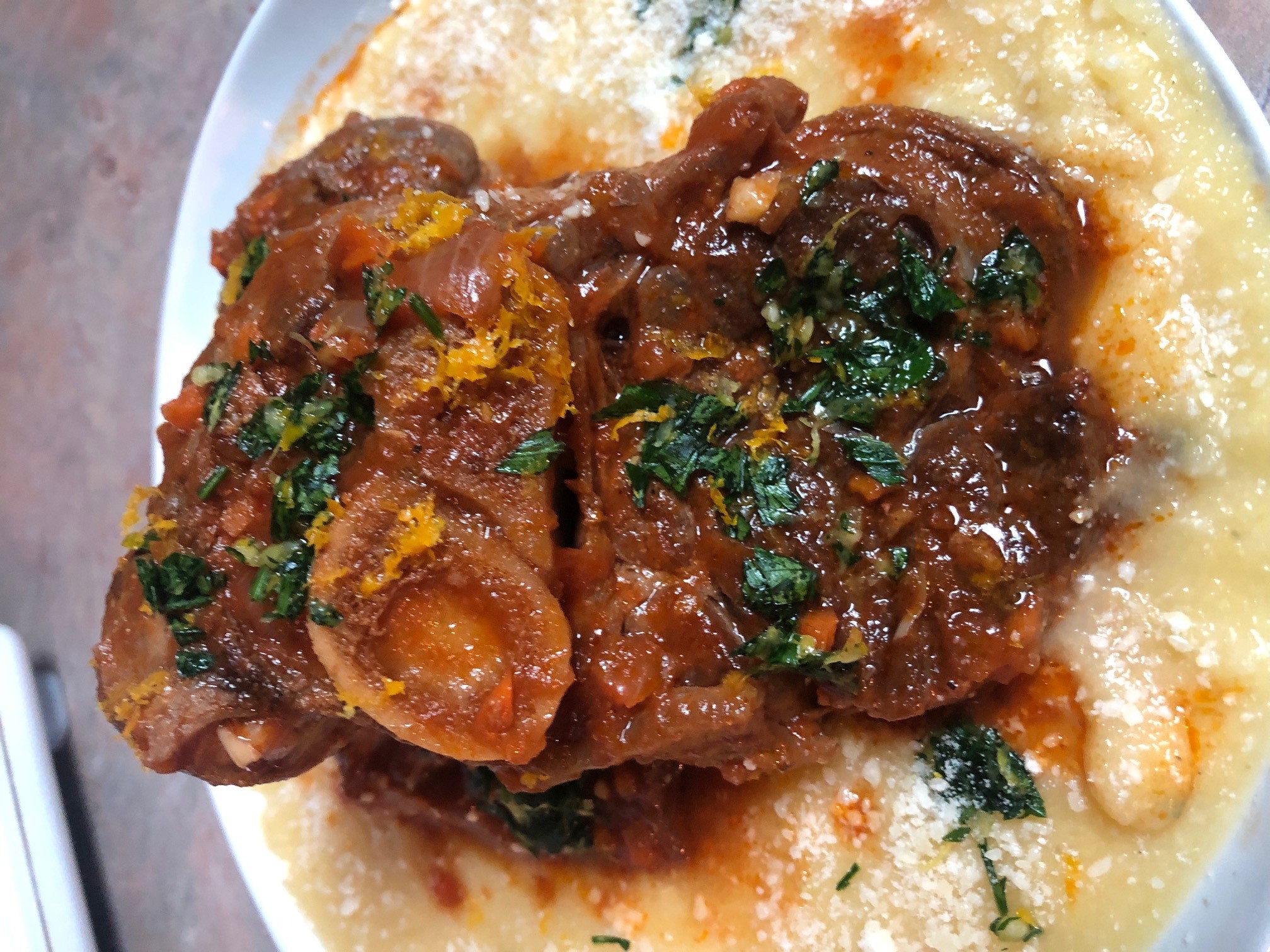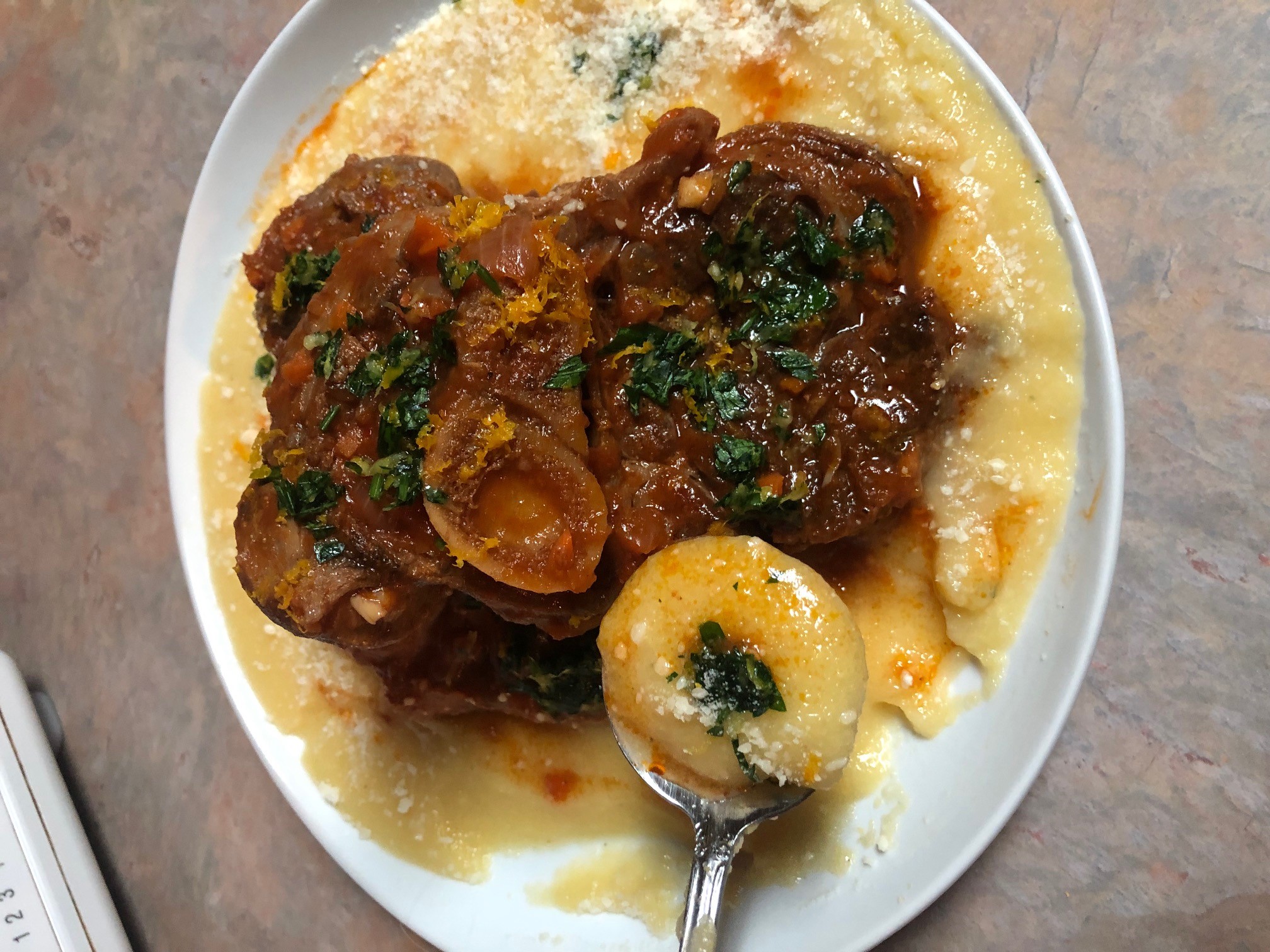Pork Shank Osso Bucco Over Creamy Polenta
R Family Farms of Lebanon, Kansas raises Berkshire pigs for their delicious, well-marbled meat. The pigs that call R Family Farms home have access to the outdoors, and find their slumber in large hoop barns deeply bedded with straw or stalks that help keep them comfy and protect them from weather elements. The Berkshire breed is also a key aspect to their farm. Berkshire is a heritage breed of pig that is known for its tender, juicy, marbled, and, dare we say it, delicious pork.
Check out the segment on Good Morning KAKEland to learn about R Family Farms and their Berkshire pork. You can shop for their pork online too and their snack sticks on Facebook!
For more tips with your Osso Bucco, check out Chef Alli's blog!

Makes 4 servings
Osso Bucco
1-2 tablespoon olive oil
4 pork shanks, 3-4 lbs., tied with string to help them hold their shape - I used pork from R Family Farms
kosher salt and freshly ground black pepper, to taste
2 small yellow onions, cut into quarters
3 large carrots, cut into thirds
3 celery stalks, cut into thirds
4 cloves garlic, peeled
smidgen of red pepper flakes
8 oz. tomato paste
1 cup dry white wine
2-3 cups chicken stock
2 bay leaves
Gremolata
1 cup fresh Italian parsley, minced
zest of 2 lemons
1 tsp. orange zest
2 cloves garlic, crushed and minced well
kosher salt and freshly ground black pepper, to taste
Polenta
1 1/2 cups medium-grind yellow cornmeal
6 cups chicken or vegetable broth
1/2 tsp. kosher salt
1/3 cup heavy cream
1/4 cup unsalted butter, chunked
1/4 cup grated Parmesan

Preheat the oven to 325 degrees F. Season the pork shanks liberally kosher salt and pepper on all sides.
Meanwhile, place the vegetables into the bowl of a food processor, pulsing 10-12 times until the vegetables are a coarse paste. (Be sure you don't over process the vegetables into a puree - they should have a bit of chunky texture to them.)
In a large Dutch oven over medium high heat, add the oil; when the oil is hot, add the seasoned pork shanks, browning them well on both sides in the hot oil. When the shanks are nicely browned, remove them to platter. Discard the oil in the Dutch oven, making sure to keep all of the browned bits in the bottom of the pot (these are gold!).
Over medium high heat, add a bit of fresh olive oil to the Dutch oven; when the oil is nicely hot, add the vegetables to the pot, letting them get nicely browned, stirring only occasionally; add the red pepper flakes and season the vegetables with a bit of kosher salt and pepper.
Once the vegetables are browned, stir in the tomato paste, letting it cook until it begins to brown. Now, deglaze the pot with the wine to loosen all the browned bits on the bottom of the pot, gently stirring it into the vegetable mixture. Let the wine cook down until reduced to about half.
Return the reserved, browned pork shanks to the Dutch oven; pour in the hot broth, then add water if needed, to bring the liquid in the pot up to the meat's shoulders. Bring the liquid to a boil, then add the bay leaves and cover the pot with the lid.
Transfer the pork to the preheated oven, letting the pork cook for 1 hour. After the first hour, check the pork to see if more liquid needs to be added to the pot; cook one more hour, then remove the lid and let the pork cook uncovered for another 30 minutes. Meanwhile, prepare the gremolata and the polenta.
Gently remove the osso bucco to a serving platter. Skim the fat from the surface of the of the sauce, then adjust the seasonings to taste.
To serve, ladle the warm polenta into four shallow serving bowls, topping each one with the pork osso bucco; cut the strings around each one. Spoon a bit of the warm sauce in the pot over the pork, then garnish with the gremolata and serve at once.

To make the gremolata, combine all the ingredients in a medium mixing bowl; season to taste with kosher salt and pepper.
Prepare the polenta in a large saucepan over medium heat; add the broth and the cornmeal, stirring to combine over medium-high heat. Add the salt and bring the polenta to a boil; immediately reduce the heat to medium or medium-low, letting the polenta simmer, partially covered with a lid, until it becomes soft, smooth and nicely thickened, approx. 25-30 minutes. Remove from the heat and stir in the cream, butter and Parmesan; adjust the seasonings to taste before serving.
Popular Categories
- Recipes
- Member features
- Savor the Season
- In the news
- Farmers markets
- Member only
- Recipes
- Membership information
- Specialty Food & Drink
- Latest happenings
- More categories ...
Popular Tags
- chef alli
- recipe
- savor the season
- kansas
- fancy food show
- social media
- farmers market
- local
- membership
- wine
- from the land of kansas
- kansas farm bureau
- hildebrand farms dairy
- alma creamery
- annual meeting
- beef
- hy-vee
- beer